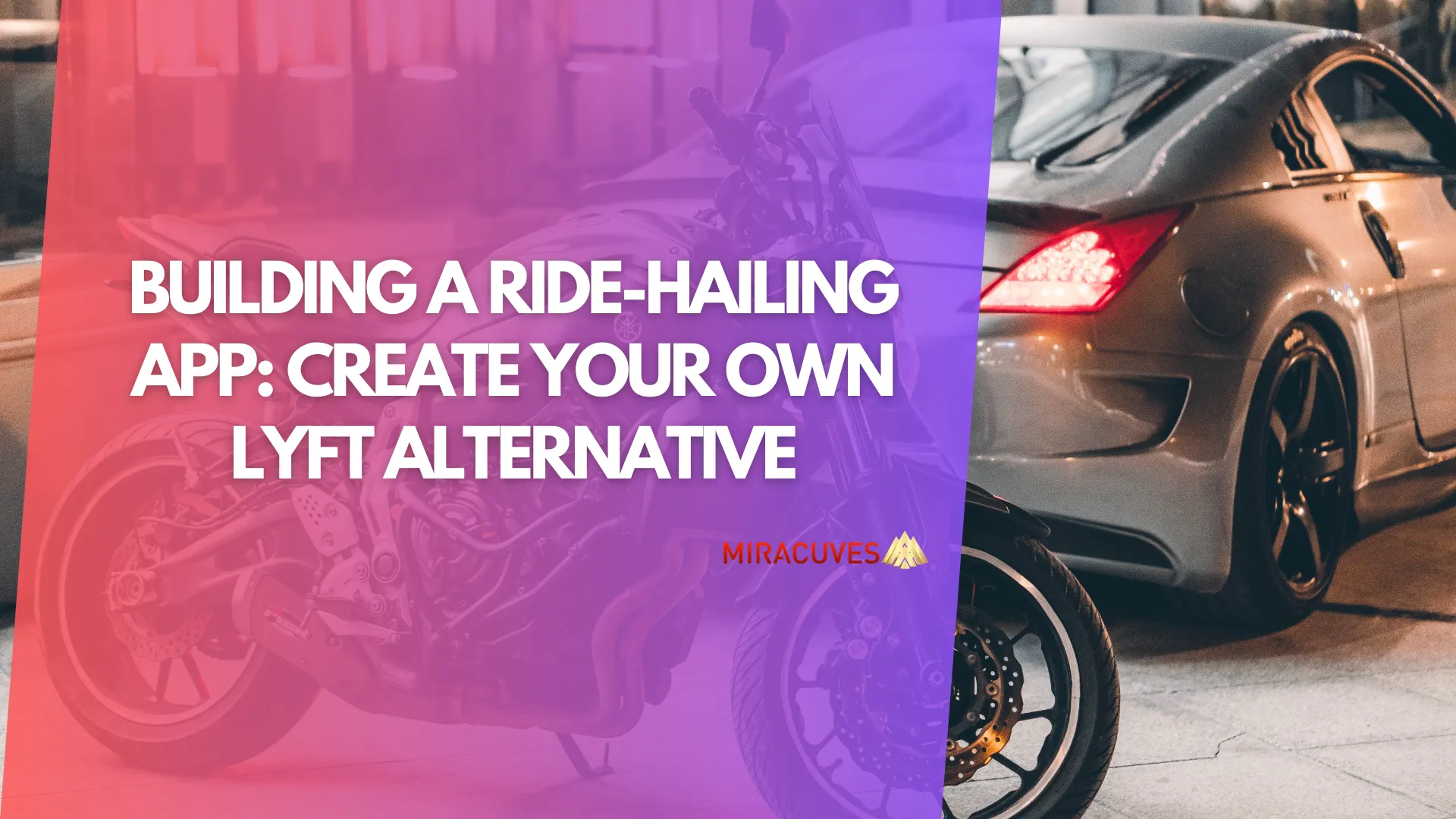Ride-hailing apps have transformed urban mobility, making it easier for people to book rides on-demand with just a few taps. As cities grow and consumers seek convenient and sustainable transportation options, the demand for these apps continues to rise. With ride-sharing services like Lyft becoming integral to modern transport, many entrepreneurs are now looking to develop alternatives that can tap into this booming market.
Building an app like Lyft offers a tremendous opportunity to cater to commuters, provide eco-friendly carpooling options, and compete with giants like Uber. However, developing such an app requires careful planning, technical expertise, and efficient execution. This guide provides everything you need to know about Building a taxi dispatch platform—from essential features and MVP strategies to the cost and timeframe advantages offered by Miracuves Solutions. Whether you’re a startup or an established business, you’ll discover actionable insights to launch your ride-hailing platform quickly and effectively.
What the App Is and What It Does
A ride-hailing app like Lyft provides users with a seamless, digital platform to book rides from their smartphones. It connects drivers with passengers in real time, offering on-demand transportation without the hassle of traditional taxis. Users can request a ride, choose their preferred vehicle type, and pay directly through the app, making it both convenient and efficient.
Beyond simple ride requests, apps like Lyft have introduced features such as carpooling options (Lyft Line), scheduled rides, and in-app tipping, creating a user-friendly experience for both drivers and passengers. These platforms rely heavily on GPS tracking and route optimization, ensuring that users know exactly when their ride will arrive and can monitor the trip in real time.
Ride-hailing apps serve multiple purposes:
- Convenience: Quick booking with transparent pricing.
- Safety: Integrated driver verification and ride-tracking features.
- Eco-Friendly Options: Carpooling reduces the number of vehicles on the road.
- Cashless Transactions: Payments processed through cards or wallets reduce friction.
These apps also empower drivers with flexible earning opportunities, creating an additional revenue stream for individuals. The appeal of ride-hailing services extends beyond individual users, serving as an urban transport solution and filling a critical gap in last-mile connectivity.
Building a Ride Hailing App means tapping into a service model that not only addresses transportation needs but also provides eco-friendly, efficient, and cost-effective solutions for modern cities.
Also Read:- How to Build a Trusted Ride App Like Safr
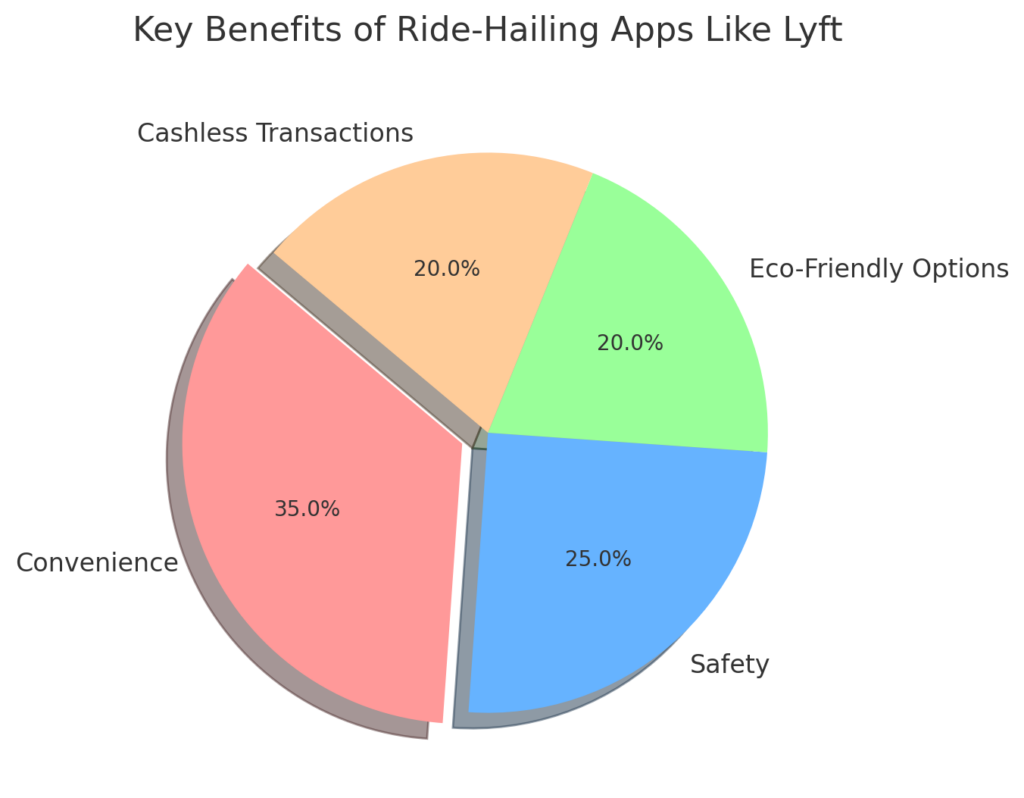
Why Build This App?
The ride-hailing industry has shown explosive growth over the past decade, driven by urbanization and changing commuter preferences. As cities become more congested, people increasingly prefer on-demand transport services like Lyft for their convenience, speed, and cost-effectiveness. For entrepreneurs and businesses, building a Lyft alternative offers the chance to tap into a multi-billion-dollar market with immense growth potential.
The key drivers behind the rise of ride-hailing apps include:
- Growing Urban Populations: More people living in cities need easy transport options.
- Cost-Effective Commuting: Carpool and shared rides reduce travel costs.
- Sustainability Initiatives: Carpool platforms contribute to fewer vehicles on the road and lower emissions.
- Changing Preferences: Consumers want flexible and cashless travel solutions without owning a vehicle.
According to recent market research, the global ride-hailing market is expected to grow by 25% annually, making it one of the most profitable tech-driven industries. Additionally, governments are encouraging sustainable mobility solutions like carpooling, opening new doors for businesses in the sector.
Building your own Lyft alternative not only meets the demand for personalized urban transport but also offers the flexibility to add innovative features and build unique value propositions. With the right tech and business strategy, entering this market is a low-risk, high-reward opportunity.
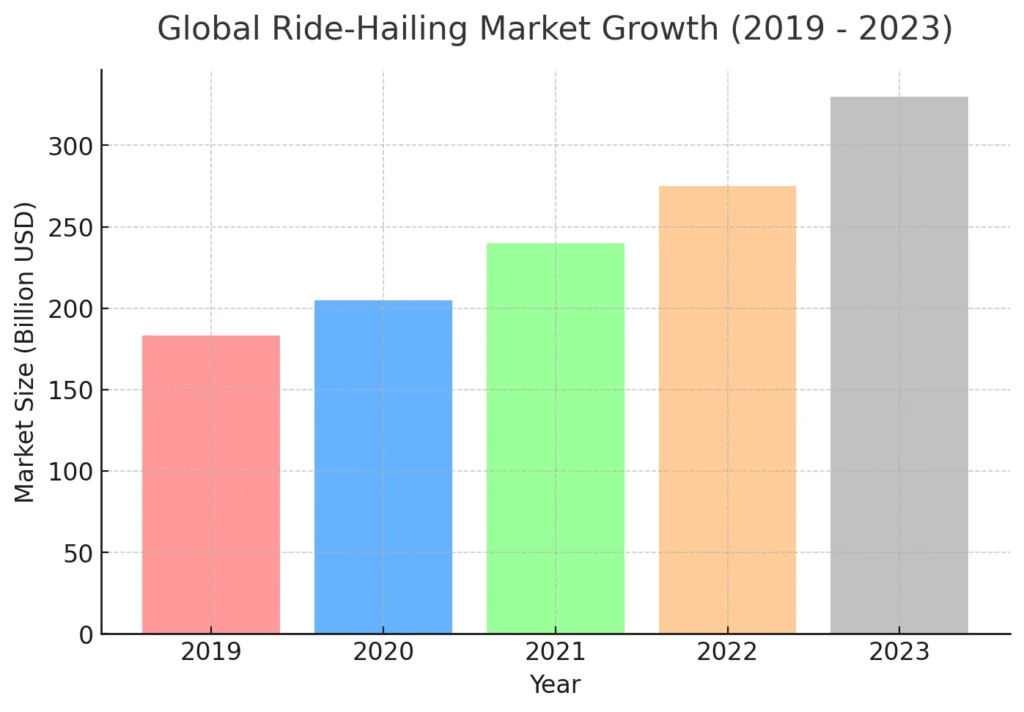
How to Differentiate from Competitors (250 Words)
The ride-hailing industry is saturated with major players like Lyft and Uber, making it essential for new entrants to find ways to stand out. Building a unique value proposition (UVP) helps create a distinct identity, attract customers, and retain users in a highly competitive market. Here are key strategies to make your Lyft alternative different:
1. Focus on Sustainability
- Offering electric vehicle (EV) rides or carbon offset options can appeal to eco-conscious consumers.
- Introduce rewards for users who opt for carpool rides, supporting greener travel habits.
2. Subscription or Loyalty Programs
- Create subscription models offering unlimited rides within a period for a fixed fee.
- Introduce loyalty points or rewards to encourage customer retention.
3. Specialized Services
- Offer niche services, like women-only rides for enhanced safety.
- Introduce pet-friendly or child-friendly options to target specific customer needs.
4. Advanced User Experience
- Provide voice-command booking options to enhance accessibility.
- Implement predictive algorithms to suggest rides based on users’ schedules.
These unique features will help your Lyft alternative offer a more customer-centric experience while also aligning with modern trends like sustainability and personalization. By embracing these innovations, you’ll stand out in the market and capture an audience looking for something beyond typical ride-hailing solutions.
| Year | Projected Market Size (Billion USD) | Annual Growth Rate (%) |
|---|---|---|
| 2024 | 360 | 9 |
| 2025 | 410 | 12 |
| 2026 | 475 | 15 |
| 2027 | 540 | 14 |
| 2028 | 620 | 15 |
Market Size and Industry Growth
The global ride-hailing market is expanding rapidly, fueled by the increasing demand for convenient urban transportation and cost-effective solutions. With people shifting away from personal vehicles toward shared mobility options, ride-hailing services are becoming essential for both individuals and cities. Market analysts project that the industry will surpass $600 billion by 2028, growing at a compound annual growth rate (CAGR) of 14% from 2024 to 2028.
Several factors are driving this growth:
- Urbanization and Population Growth: More people in cities need easy access to transport solutions.
- Technological Advancements: Improved GPS, mobile apps, and AI are making ride-hailing services more efficient.
- Government Support for Sustainable Mobility: Incentives for carpooling and EV rides boost the sector.
- Rising Demand for Alternative Mobility Solutions: Consumers are seeking more flexible and affordable transport options.
The industry is also witnessing regional variations. Asia-Pacific holds the largest market share due to its dense urban population, while North America remains a lucrative market driven by high demand for premium ride options. The European market is catching up as carpooling and sustainable mobility gain momentum.
This growth presents an excellent opportunity for new entrants to develop ride-hailing apps, especially those focusing on innovative features or sustainability initiatives, helping them capture a slice of this booming industry.
Key Features of the App
Building a successful ride-hailing app like Lyft requires a set of core features to provide a smooth user experience for passengers and drivers. These features ensure convenience, safety, and operational efficiency, setting your platform apart from traditional taxi services.
1. Core Features
- Real-Time GPS Tracking: Enables passengers to track their ride from booking to destination.
- Multiple Payment Options: Offers secure payment through cards, wallets, or cashless transactions.
- Ride Scheduling: Allows users to schedule rides in advance for better planning.
- Driver and Passenger Ratings: Builds trust and improves service quality by enabling mutual feedback.
2. Optional Features to Enhance User Experience
- Loyalty Programs: Offer rewards or discounts for regular customers to boost retention.
- Multi-Destination Rides: Let passengers add multiple stops within a single ride.
- In-App Chat Support: Facilitates easy communication between drivers and passengers without sharing personal numbers.
- Ride-Sharing (Carpool) Mode: Allows users to share rides and split costs, promoting sustainability.
The balance between core and optional features is crucial during development. Launching with a Minimum Viable Product (MVP) containing essential features ensures you enter the market quickly and gather feedback to refine your platform. As your platform grows, you can introduce advanced features based on user needs and industry trends.
Also Read:-Build a Profitable Taxi App Like Curb
MVP and Development Approach
When building a ride-hailing app, starting with a Minimum Viable Product (MVP) is a smart strategy. An MVP focuses on delivering the core features necessary to meet users’ basic needs, helping businesses launch quickly, gather feedback, and iterate improvements. This lean approach reduces risks and ensures the product resonates with its audience before expanding with advanced features.
Core Features to Include in the MVP:
- User Registration and Login: Simple onboarding for drivers and passengers.
- Ride Booking and Tracking: Allow users to book a ride and track it in real-time.
- Payment Integration: Enable card payments or digital wallets.
- Rating and Review System: Collect feedback to maintain service quality.
Developing with an MVP approach ensures the fastest path to market, which is essential in the competitive ride-hailing industry. Miracuves Solutions specializes in delivering MVPs quickly and efficiently, providing ready-made designs and features that cut development time down to one day instead of a month. Once your app gains traction, you can introduce advanced features like ride-sharing, loyalty programs, or predictive algorithms.
Development Stages with MVP:
- Research & Ideation: Identify essential features.
- Wireframing & Prototyping: Visualize the user journey.
- Development & Testing: Build and refine the core features.
- Launch & Feedback Collection: Use real-time feedback to iterate.
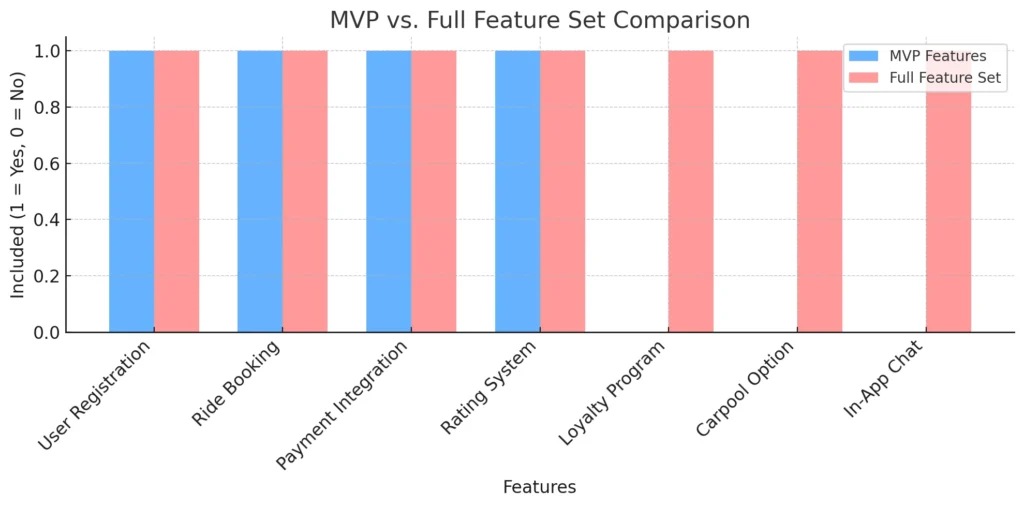
Technical Requirements
Building a ride-hailing app requires a robust tech stack that ensures smooth performance, fast loading times, and secure transactions. Selecting the right combination of technologies is crucial to developing an app that can scale efficiently as user demand grows. Here’s a breakdown of the essential technical components for a ride-hailing app:
1. Frontend Development
- Frameworks: React Native or Flutter – Both offer cross-platform compatibility for iOS and Android.
- Design Tools: Figma or Adobe XD to create an intuitive UI/UX.
2. Backend Development
- Languages: Node.js or Django for handling large-scale data requests efficiently.
- Database: MySQL or MongoDB for managing user profiles, bookings, and payments.
3. APIs and Third-Party Integrations
- Payment Gateways: Stripe, PayPal, or Razorpay for secure transactions.
- Maps and Navigation: Google Maps API or OpenStreetMap for real-time tracking and navigation.
4. Cloud Hosting and Storage
- Use AWS or Google Cloud for reliable, scalable infrastructure.
The goal is to ensure that the tech stack supports high performance even during peak usage, with secure data handling to protect user information. Choosing the right technologies will also impact development speed. Miracuves Solutions offers pre-built frameworks compatible with these technologies, helping businesses reduce development time significantly.
For optimal performance and scalability, hosting your app on a trusted cloud platform like AWS is recommended. With AWS, you can manage infrastructure efficiently, handle sudden traffic spikes, and store data securely.
Design and User Interface (UI/UX)
A well-designed user interface (UI) and seamless user experience (UX) are crucial for a ride-hailing app’s success. In a competitive space, users expect the app to be intuitive, easy to navigate, and visually appealing. The goal of UI/UX design is to minimize friction and ensure both passengers and drivers can complete tasks with minimal effort.
Key Principles for UI/UX Design
- Simplicity and Clarity:
- Avoid clutter by only showing relevant information on each screen.
- Use a minimalist design with intuitive icons and buttons.
- Personalized Experience:
- Implement user preferences for quick bookings (like saved locations).
- Offer localized UI in multiple languages for different regions.
- Responsive Design:
- Ensure the app performs well on all devices and screen sizes.
- Dark mode support is increasingly popular for better accessibility.
- Fast Loading Times:
- Reduce loading times by optimizing images and code. Users expect instant responses, especially when booking rides.
- Design Tools for Development:
- Use tools like Figma or Adobe XD to prototype and test designs before implementation.
Great UI/UX ensures users will engage more frequently with the app, resulting in better retention rates. Miracuves Solutions provides ready-made templates that adhere to these principles, helping businesses accelerate design timelines.
Also Read:- Develop Super Apps Like Gojek
From automated driver dispatching to real-time ride tracking!
Our ride-hailing app solution provides everything you need for a
seamless transportation experience.
Development Process
Building a ride-hailing app requires a structured development process to ensure everything from design to deployment runs smoothly. Breaking the project into smaller stages makes it easier to manage, test, and deliver on time. Below is a step-by-step development approach for a ride-hailing platform.
1. Research & Planning
- Conduct market research to understand user needs and competitors.
- Define the core features and create a project timeline.
2. Wireframing & Prototyping
- Use wireframes to outline the app’s flow and functionality.
- Create interactive prototypes using tools like Figma to gather early feedback.
3. Frontend & Backend Development
- Frontend: Build a user interface that works smoothly on both iOS and Android.
- Backend: Develop a scalable backend to handle ride bookings, payments, and user data efficiently.
4. Testing & Quality Assurance
- Test the app across devices to identify and fix bugs.
- Conduct load testing to ensure the app performs well under high traffic.
5. Deployment & Maintenance
- Launch the app on App Store and Google Play.
- Monitor feedback and update the app regularly with new features and improvements.
Developing a ride-hailing app typically takes weeks or months, but Miracuves Solutions can drastically reduce this timeframe to just one day through their pre-built components and ready-to-deploy frameworks.
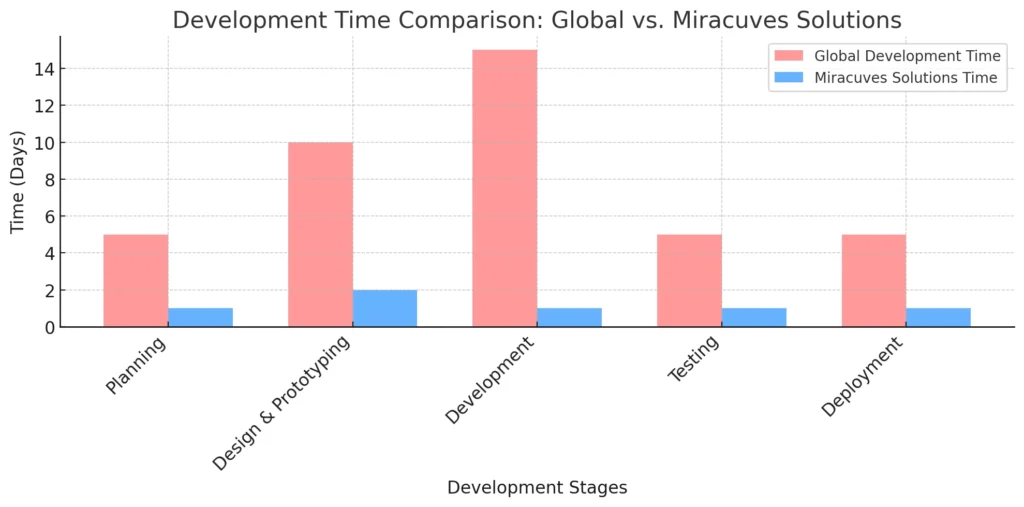
Cost Estimation and Timeframe
Developing a ride-hailing app like Lyft involves multiple cost components, including design, development, testing, and maintenance. Globally, the average cost of developing a basic ride-hailing app is around $6000 or more, depending on the complexity and features. This price can escalate further with advanced features such as ride-sharing, loyalty programs, and in-app chat systems.
However, Miracuves Solutions offers a cost-effective alternative with prices set at 10% of the global average. This means that a project that would typically cost $6000 can be developed by Miracuves Solutions for just $600—making it an ideal option for startups and entrepreneurs with a limited budget.
Cost Breakdown
- UI/UX Design: $200 globally, $20 with Miracuves.
- Frontend & Backend Development: $1500 globally, $150 with Miracuves.
- Testing & Quality Assurance: $1000 globally, $100 with Miracuves.
- Deployment & Maintenance: $500 globally, $50 with Miracuves.
Development Time Comparison
Globally, the development timeline for a ride-hailing app can range from one month to several months. With Miracuves Solutions, the entire development process can be completed in just one day, thanks to Readymade Solutions and frameworks that significantly reduce time and effort.
| Service Component | Global Cost (USD) | Miracuves Solutions Cost (USD) |
|---|---|---|
| UI/UX Design | 2000 | 200 |
| Frontend Development | 1500 | 150 |
| Backend Development | 2000 | 200 |
| Testing & Quality Assurance | 1000 | 100 |
| Deployment & Maintenance | 500 | 50 |
Monetization Strategies
Monetizing a ride-hailing app requires multiple revenue streams to ensure sustainability and profitability. Here are the most effective monetization models used by successful platforms like Lyft, Uber, and other ride-hailing services:
1. Commission-Based Model
- The app takes a percentage of each ride’s fare, typically ranging from 15% to 30%. This is a standard practice in the ride-hailing industry.
- It ensures that revenue grows in proportion to the number of bookings, offering scalability.
2. Surge Pricing
- During high-demand periods (like rush hours or bad weather), the app charges higher fares to balance supply and demand.
- This strategy not only increases revenue but also incentivizes more drivers to be available during peak hours.
3. Subscription Model for Riders
- Offer monthly or annual subscriptions for unlimited or discounted rides, giving customers an incentive to remain loyal to the platform.
- This model provides consistent income while enhancing customer retention.
4. In-App Advertising
- Display targeted ads within the app, either during the booking process or while users are tracking their rides.
- Collaborate with local businesses or brands to generate additional ad revenue.
5. Partnerships with Businesses
- Partner with restaurants, hotels, or events to offer exclusive ride packages, attracting new customers while earning commissions from partners.
A combination of these strategies ensures a stable income flow while also improving user satisfaction and engagement.
To ensure secure payments and smooth transactions, integrating a reliable payment gateway is essential. Many successful ride-hailing platforms use Stripe for processing payments, offering seamless card payments and digital wallets. This ensures users can pay effortlessly while businesses maintain secure financial operations.
Launching and Marketing the App
A successful launch requires more than just a functional app; it demands strategic marketing efforts to capture user interest and create a buzz. Here’s a breakdown of how to effectively launch and promote your ride-hailing app.
1. Pre-Launch Strategy
- Beta Testing: Invite a small group of users to test the app before the official launch. Gather feedback and fix any bugs.
- Social Media Teasers: Use platforms like Instagram, Twitter, and Facebook to share sneak peeks, building anticipation among potential users.
- Press Releases and Blogs: Publish articles and press releases about your app’s features and benefits to attract media attention.
2. Launch Day Activities
- Offer first-ride discounts or promotional codes to encourage people to try the app.
- Engage users with referral programs, where both the referrer and the new user receive discounts.
- Ensure your app is available on both Google Play and the App Store for maximum reach.
3. Post-Launch Marketing and Growth
- SEO and Paid Ads: Optimize your app’s website for search engines and run targeted ads to acquire users.
- Influencer Marketing: Collaborate with influencers to promote your app to a larger audience.
- Monitor app performance through analytics tools to understand user behavior and fine-tune your strategies.
A well-executed marketing plan not only ensures a smooth launch but also builds a loyal user base over time. With the right mix of promotions, partnerships, and paid ads, your ride-hailing app can gain significant traction in the competitive market.
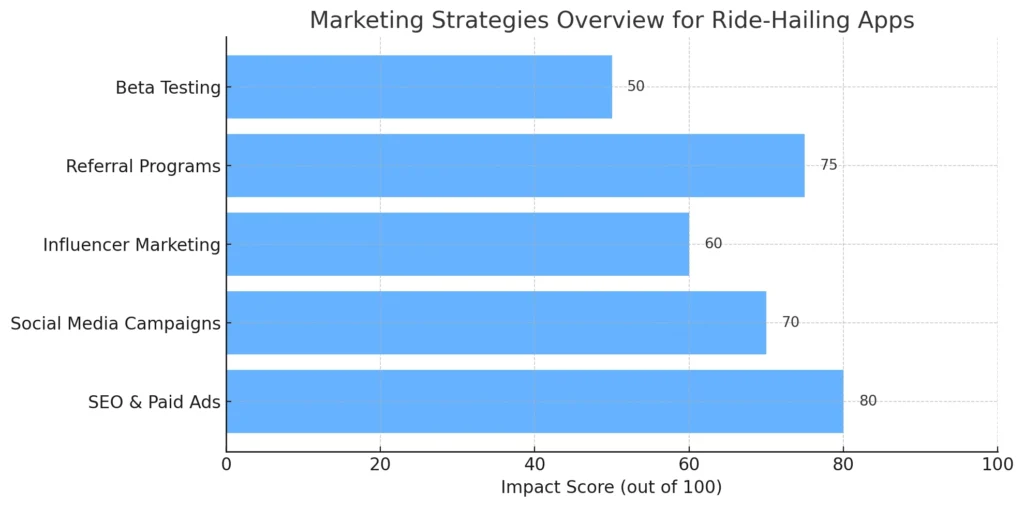
Legal and Regulatory Considerations
Launching a ride-hailing app requires careful attention to legal and regulatory requirements to avoid fines and ensure smooth operations. Ride-hailing companies operate in a regulated environment, especially in areas like data privacy, passenger safety, and licensing.
1. Data Privacy Compliance
- Your app must comply with privacy regulations like the General Data Protection Regulation (GDPR) in Europe or the California Consumer Privacy Act (CCPA) in the U.S.
- Implement a clear privacy policy that informs users how their data will be collected, stored, and used.
2. Driver and Vehicle Regulations
- Verify that all drivers have valid licenses, vehicle permits, and insurance.
- Some cities may require special permits for ride-hailing drivers to operate legally.
3. Safety and Liability
- Include features like emergency buttons and background checks for drivers to ensure passenger safety.
- Liability insurance is essential to protect both the business and the drivers in case of accidents or disputes.
4. Terms and Conditions for Users
- Develop a comprehensive Terms of Service (ToS) that clearly outlines the app’s usage policies, refund process, and user responsibilities.
5. Compliance with Local Transport Regulations
- Many cities have specific rules for ride-hailing services, such as fare caps or ride-sharing restrictions. It’s essential to stay updated on local laws to avoid penalties.
Navigating legal compliance ensures that your app builds trust with users and regulators while avoiding disruptions to operations.
Future Growth and Scalability
A ride-hailing app’s success depends on its ability to scale seamlessly and adapt to market changes. Building a platform with scalability in mind ensures that the app can handle increased traffic, expand into new markets, and evolve with user expectations over time. Here’s how you can design your app for future growth:
1. Expand to New Markets and Regions
- Once the app gains traction locally, you can expand to other cities or countries, targeting new user bases.
- Integrate multi-language and multi-currency support to attract a global audience.
2. Introduce New Services and Features
- As your user base grows, you can add premium ride options (like luxury vehicles) or introduce subscription services.
- Offering shared rides or partnerships with public transport networks can further enhance growth and user engagement.
3. Cloud-Based Scalability
- Use cloud infrastructure (like AWS or Google Cloud) to ensure your app can handle sudden spikes in demand without downtime.
- Horizontal scaling allows you to add more servers as traffic increases, ensuring consistent performance.
4. Data-Driven Improvements
- Use real-time analytics to monitor performance and customer behavior, helping you identify trends and make improvements quickly.
- Personalized recommendations based on past rides can improve customer experience and retention.
Building with scalability ensures your app remains competitive and profitable as the market evolves. With the right strategy, you can capture new growth opportunities and expand effortlessly.
| Scalability Feature | Custom Solution | Market Solution |
|---|---|---|
| Horizontal Scaling | Yes | Limited |
| Vertical Scaling | Yes | Yes |
| Real-Time Analytics | Optional | No |
| Data Backup & Recovery | Yes | Optional |
| Multi-Region Deployment | Yes | Limited |
Why Trust Miracuves Solutions for Your Next Project?
Choosing the right partner for app development is crucial for turning your vision into reality. Miracuves Solutions stands out as the ideal choice for developing your ride-hailing app, offering a combination of cost-effectiveness, speed, and high-quality delivery that few others can match.
1. Unmatched Affordability
- 10% of the global average cost: Where building a ride-hailing app typically costs $6000 or more, Miracuves Solutions delivers the same project for just $600 without compromising on quality.
2. Lightning-Fast Development
- While conventional development can take weeks to months, Miracuves Solutions offers 1-day delivery through pre-built designs, templates, and frameworks. This allows businesses to launch fast and start generating revenue early.
3. Ready-Made, Scalable Solutions
- Miracuves provides scalable frameworks that grow with your business. Whether it’s expanding to new markets or adding advanced features, your app will be ready to adapt without delays.
4. Compliance and Risk Management
- With a deep understanding of legal and regulatory frameworks, Miracuves ensures that your app complies with data privacy laws and transport regulations, minimizing operational risks.
Choosing Miracuves Solutions means gaining a trusted partner dedicated to helping you succeed in the competitive ride-hailing industry. With affordable, fast, and reliable solutions, your business can grow effortlessly while staying ahead of market trends. Contact Us Today!!
Conclusion
Building a ride-hailing app like Lyft offers an exciting opportunity to enter a thriving industry driven by convenience and innovation. With the right mix of core features, efficient development strategies, and thoughtful design, your app can quickly attract users and build a loyal customer base. However, launching a successful app requires more than just great ideas—it needs fast execution, cost efficiency, and scalability to stay competitive.
Miracuves Solutions provides the perfect foundation for your project, delivering high-quality apps at just 10% of the global cost and reducing development time to just one day. With their ready-made solutions, you can hit the ground running, adapt quickly to market needs, and scale seamlessly as your user base grows.
By choosing Miracuves Solutions, you gain more than just a development partner—you gain a trusted ally dedicated to your success. Now is the time to bring your Lyft alternative to life and make your mark in the ride-hailing industry.
Launch a ride-hailing service with ease!
From ride-matching algorithms to multi-payment
options, we help businesses develop efficient and customer-centric transportation platforms.
FAQs
What is the cost of building a ride-hailing app like Lyft?
Globally, the cost can range from $6000 to $10,000 depending on the features. However, Miracuves Solutions offers the same high-quality app for just $600, providing a budget-friendly alternative without compromising on performance.
How long does it take to develop a ride-hailing app?
Traditional development takes 1 to 3 months. With Miracuves Solutions, the entire process is completed within 1 day using pre-built components and frameworks, allowing businesses to launch quickly and start generating revenue sooner.
What features are essential in an MVP for a ride-hailing app?
An MVP should include ride booking, real-time tracking, payment integration, and rating systems. These core features help ensure the app meets basic user expectations and allows for quick feedback to refine the product.
How can I scale my ride-hailing app as demand grows?
Use cloud-based infrastructure like AWS to ensure scalability. Focus on adding new services (e.g., carpooling) and expanding to other cities with multi-currency and language support to tap into global markets.
Why should I choose Miracuves Solutions for app development?
Miracuves Solutions provides affordable, fast, and scalable solutions, ensuring your app meets industry standards at just 10% of the global cost. With their experience in the field, you’ll have a trusted partner for long-term success.



